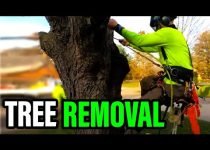How to Do Tree Removal Safely and Efficiently
Whether you’re looking to remove a tree that’s dangerous, diseased or just unsightly, it’s important to get it done right. The right approach can prevent damage to nearby homes and vehicles, minimize the chance of injury, and ensure that your yard remains beautiful for years to come.
Removing a Tree
A tree’s roots grow into the ground and help it survive. But they also draw water to the top, creating an attractive oasis for birds and other wildlife. If you’re considering tree removal, be sure to research how much water the roots need to thrive.
It’s also a good idea to check with local authorities about any restrictions on removing trees in your area. In some areas, illegally removing trees can lead to serious fines.
You can also hire a professional arborist to take down a tree that is becoming a safety or health risk, such as a dying or dangerous branch. These specialists are well-versed in how to safely handle a tree and can make the whole process easy for you.
Doing Tree Removal Safely and Efficiently
Removing a tree can be a frustrating experience, especially if it’s in an unsafe or hard-to-reach spot. You may even be worried that the tree will fall on a car, fence or other property. The best way to avoid these issues is by taking your time and following a few safety precautions.
First, circle the tree from all angles and consider which way it’s likely to lean once it’s cut down. This will let you determine which direction the tree is most likely to fall in and give you a better idea of where it will hit things if it falls on them.
Once you’ve determined the direction the tree will fall, clear a primary and secondary escape route from the non-falling side of the tree. These routes should be about 45 degrees away from each other in opposite directions, so you can quickly find them if something goes wrong and the tree starts to fall.
Then, use a chainsaw or saw to slice the trunk and lower limbs of the tree. Once the limbs are gone, you can remove the trunk from the landscape and dispose of it as a waste product.
If the trunk is over 10 inches high, it’s best to call in a professional. A professional tree cutter will cut the tree into pieces so it can be removed piece by piece. The limbs will be chopped up and hauled off site, usually to a recycling center or compost pile.
When hiring a professional, check their credentials and experience. Look for companies with a long history in your community and a solid reputation. They should have insurance and be bonded.
In addition, they should be certified by the International Society of Arboriculture (ISA). This certification means that the arborist has met rigorous standards for their expertise.
Removing a Tree Conclusion: A lot of people don’t know how to properly cut down a tree. They’re often tempted to save money by tackling the job themselves, but this can be dangerous. Besides, saving money could mean expensive repairs to your home or vehicle.


